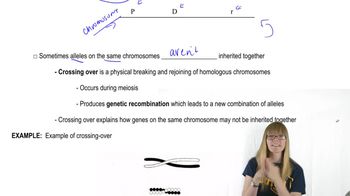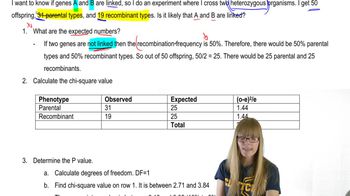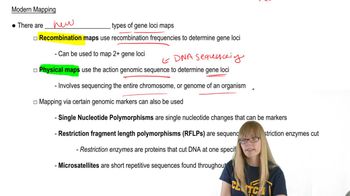Table of contents
- 1. Introduction to Genetics51m
- 2. Mendel's Laws of Inheritance3h 37m
- 3. Extensions to Mendelian Inheritance2h 41m
- 4. Genetic Mapping and Linkage2h 28m
- 5. Genetics of Bacteria and Viruses1h 21m
- 6. Chromosomal Variation1h 48m
- 7. DNA and Chromosome Structure56m
- 8. DNA Replication1h 10m
- 9. Mitosis and Meiosis1h 34m
- 10. Transcription1h 0m
- 11. Translation58m
- 12. Gene Regulation in Prokaryotes1h 19m
- 13. Gene Regulation in Eukaryotes44m
- 14. Genetic Control of Development44m
- 15. Genomes and Genomics1h 50m
- 16. Transposable Elements47m
- 17. Mutation, Repair, and Recombination1h 6m
- 18. Molecular Genetic Tools19m
- 19. Cancer Genetics29m
- 20. Quantitative Genetics1h 26m
- 21. Population Genetics50m
- 22. Evolutionary Genetics29m
4. Genetic Mapping and Linkage
Mapping Genes
Problem 8a
Textbook Question
Gene G recombines with gene T at a frequency of 7%, and gene G recombines with gene R at a frequency of 4%.
Draw two possible genetic maps for these three genes, and identify the recombination frequencies predicted for each map.
 Verified step by step guidance
Verified step by step guidance1
<span>Step 1: Understand that recombination frequency is a measure of genetic linkage and is used to estimate the distance between genes on a chromosome. A 1% recombination frequency is equivalent to 1 map unit or 1 centimorgan (cM).</span>
<span>Step 2: Given the recombination frequencies, we have: G-T = 7% (7 cM) and G-R = 4% (4 cM). We need to determine the possible arrangements of these genes on a chromosome.</span>
<span>Step 3: Consider the first possible map: Place gene G in the middle. This would mean the map could be R-G-T, with R-G = 4 cM and G-T = 7 cM. Calculate the total distance between R and T.</span>
<span>Step 4: Consider the second possible map: Place gene T in the middle. This would mean the map could be G-T-R, with G-T = 7 cM and T-R = 4 cM. Calculate the total distance between G and R.</span>
<span>Step 5: For each map, verify the consistency of the recombination frequencies with the given data and ensure that the total distance between the outer genes matches the sum of the individual distances.</span>
Recommended similar problem, with video answer:
 Verified Solution
Verified SolutionThis video solution was recommended by our tutors as helpful for the problem above
Video duration:
1mPlay a video:
Was this helpful?
Key Concepts
Here are the essential concepts you must grasp in order to answer the question correctly.
Recombination Frequency
Recombination frequency is a measure of the likelihood that two genes will be separated during meiosis due to crossing over. It is expressed as a percentage, indicating the proportion of offspring that exhibit a recombinant phenotype. For example, a recombination frequency of 7% between genes G and T suggests that 7% of the gametes will have a combination of alleles different from the parental types.
Recommended video:
Guided course

Recombination after Single Strand Breaks
Genetic Mapping
Genetic mapping involves determining the relative positions of genes on a chromosome based on recombination frequencies. By analyzing how often genes recombine, researchers can create a map that shows the order and distance between genes. This is crucial for predicting inheritance patterns and understanding genetic linkage, which can influence traits in offspring.
Recommended video:
Guided course

Mapping Overview
Linkage and Gene Order
Linkage refers to the tendency of genes located close to each other on a chromosome to be inherited together. The order of genes can be inferred from recombination frequencies; genes that are further apart are more likely to recombine. Understanding the linkage and order of genes G, T, and R is essential for accurately drawing genetic maps and predicting recombination outcomes.
Recommended video:
Guided course

Chi Square and Linkage
Related Videos
Related Practice





